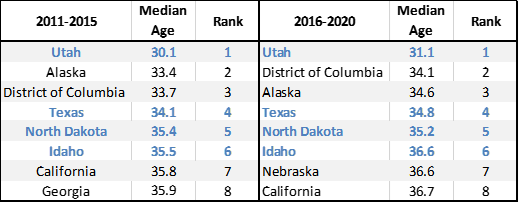Census Data: Idaho is 6th youngest state

IDAHO FALLS, Idaho (KIFI) - Idaho remains one of the youngest states in the nation while the state’s population growth and home pricing increases top national rates, according to the recently released results from the U.S. Census Bureau’s 2016-2020 American Community Survey.
The release includes new tables on the civilian-employed population (age 16 and older), along with data on computer and internet use.
Some of the statistically significant changes for Idaho include:
Age
Idaho remained the sixth youngest state in the nation with a median age of 36.6 years. Utah retained its rank as the youngest with a median age of 31.1 years. Except for North Dakota, all 50 states and the District of Columbia experienced an increase in the median age. The nation’s median age was 38.2 years and is up slightly from its 37.6 years median age in 2015.

Median Ages Table
The states with the oldest or highest median age were concentrated on the eastern side of the U.S. starting with Maine (44.8 years), New Hampshire (43 years), Vermont (42.8 years), West Virginia (42.7 years), Florida (42.2 years), Connecticut (41.1 years), Delaware (41 years) and Pennsylvania (40.9 years).
Workforce Characteristics
The average commuting time for Idahoans increased from 20.2 minutes to 21.2 minutes.
The percentage of Idahoans working from home increased from 5.9% to 7.8%.
Three Idaho counties with popular tourist destinations reported the highest incidence of teleworking: Blaine County at 12.8%, Teton County at 14.1% and Valley County at 15.5%.
Income
Idaho’s median household income increased 13.1% from $52,096 to $58,915, unadjusted for inflation.
Idaho counties with the highest median household income are Teton ($73,274), Ada ($69,952), Jefferson ($65,577), Blaine ($54,627) and Valley ($63,115).
Five counties experienced a decrease in median household income: Bear Lake (-.9%), Blaine (-.8%), Caribou (-7.8%), Elmore (-4.9%) and Shoshone (-.8%).
Migration
Idaho ranked fourth nationally with 4.4% of the population coming from a different state. Other states with high in-migration included District of Columbia (8.2%), North Dakota and Wyoming (both at 4.5%).
Almost 17% of Idaho’s population moved during 2016-2020 while about 14% of the nation’s population moved during the same period.
The median age for those moving to Idaho from out of state was 28.7 years.
At 8.5%, a significant share of Idaho’s population moved within the same county over the 2016-2020 period. The national rate was 7.7%.
The states with the highest levels of movement within the same county were predominantly in the Western U.S. and included Nevada at 11.2%, Arizona at 10.8%, Washington at 9.8%, Alaska and District of Columbia at 9.7%, Wyoming at 9.4%, Utah at 9.3%, Oregon and Oklahoma at 9.1%.
Housing and Households
The number of Idaho households grew by 8.4% with homeowners making up 71% of occupied housing and renters comprising 29%.
The share of renters declined in the past five years while owner-occupied housing increased.
The U.S. Census Bureau was required to use a revised methodology for the release of 2016 – 2020 American Community Survey data to account for a low response rate and non-response bias caused by COVID-19 pandemic disruptions.
The American Community Survey was founded before the 2010 Census and released its first set of multi-year estimates in 2008. It replaced the decennial Census long form to provide more timely statistics, rather than waiting every 10 years.
The survey contacts 3.5 million addresses annually covering 40+ topics and creating 1,140 detailed tables, 83 subject tables, five comparison profiles, narrative profiles and multiple online Census tools. The survey data is used to help allocate more than $675 billion in federal funds.
The data is available at data.census.gov.






